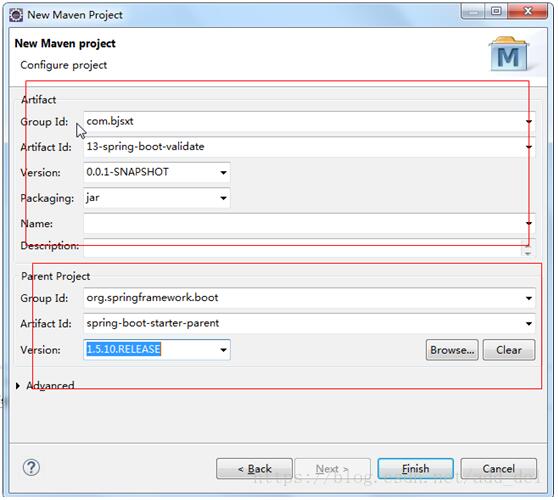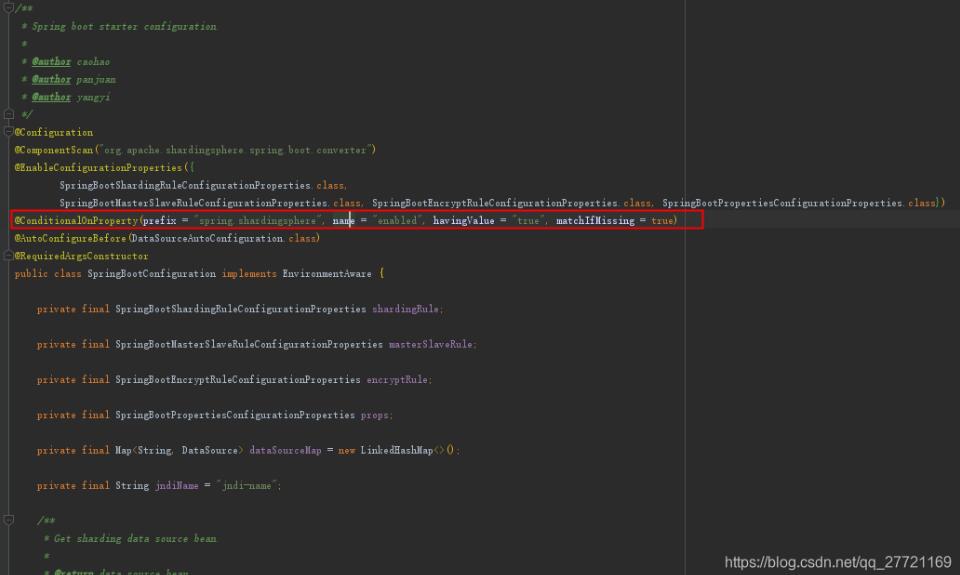基于SpringBoot服务端表单数据校验的实现方式
SpringBoot服务端表单数据校验
(SpringBoot高级)
一、实现添加用户功能
1 创建项目

2 修改POM文件
<project xmlns="http://maven.apache.org/POM/4.0.0" xmlns:xsi="http://www.w3.org/2001/XMLSchema-instance" xsi:schemaLocation="http://maven.apache.org/POM/4.0.0 http://maven.apache.org/xsd/maven-4.0.0.xsd"> <modelVersion>4.0.0</modelVersion> <parent> <groupId>org.springframework.boot</groupId> <artifactId>spring-boot-starter-parent</artifactId> <version>1.5.10.RELEASE</version> </parent> <groupId>com.bjsxt</groupId> <artifactId>13-spring-boot-validate</artifactId> <version>0.0.1-SNAPSHOT</version> <properties> <java.version>1.7</java.version> <thymeleaf.version>3.0.2.RELEASE</thymeleaf.version> <thymeleaf-layout-dialect.version>2.0.4</thymeleaf-layout-dialect.version> </properties> <dependencies> <!-- springBoot的启动器 --> <dependency> <groupId>org.springframework.boot</groupId> <artifactId>spring-boot-starter-web</artifactId> </dependency> <!-- thymeleaf的启动器 --> <dependency> <groupId>org.springframework.boot</groupId> <artifactId>spring-boot-starter-thymeleaf</artifactId> </dependency> </dependencies> </project>
3 编写添加用户功能
3.1 创建实体类
publicclass Users {
private String name;
private String password;
private Integer age;
public String getName() {
returnname;
}
publicvoid setName(String name) {
this.name = name;
}
public String getPassword() {
returnpassword;
}
publicvoid setPassword(String password) {
this.password = password;
}
public Integer getAge() {
returnage;
}
publicvoid setAge(Integer age) {
this.age = age;
}
@Override
public String toString() {
return"Users [name=" + name + ", password=" + password + ", age=" + age + "]";
}
}
3.2 编写Controller
/**
* SpringBoot 表单数据校验
*
*
*/
@Controller
publicclass UsersController {
@RequestMapping("/addUser")
public String showPage(){
return"add";
}
/**
* 完成用户添加
*/
@RequestMapping("/save")
public String saveUser(Users users){
System.out.println(users);
return"ok";
}
}
3.3 编写页面add.html ok.html
<!DOCTYPE html>
<html>
<head>
<meta charset="UTF-8">
<title>添加用户</title>
</head>
<body>
<form th:action="@{/save}" method="post">
用户姓名:<input type="text" name="name"/><br/>
用户密码:<input type="password" name="password" /><br/>
用户年龄:<input type="text" name="age" /><br/>
<input type="submit" value="OK"/>
</form>
</body>
</html>
<!DOCTYPE html>
<html>
<head>
<meta charset="UTF-8">
<title>操作成功</title>
</head>
<body>
OK。。。。
</body>
</html>
二、SpringBoot对表单做数据校验
1 SpringBoot对表单数据校验的技术特点
1.1 SpringBoot中使用了Hibernate-validate校验框架
2 SpringBoot表单数据校验步骤
2.1 在实体类中添加校验规则
publicclass Users {
@NotBlank//非空校验
private String name;
@NotBlank//密码非空校验
private String password;
private Integer age;
public String getName() {
returnname;
}
publicvoid setName(String name) {
this.name = name;
}
public String getPassword() {
returnpassword;
}
publicvoid setPassword(String password) {
this.password = password;
}
public Integer getAge() {
returnage;
}
publicvoid setAge(Integer age) {
this.age = age;
}
@Override
public String toString() {
return"Users [name=" + name + ", password=" + password + ", age=" + age + "]";
}
}
2.2 在Controller中开启校验
/**
* 完成用户添加
*@Valid开启对Users对象的数据校验
*BindingResult:封装了校验的结果
*/
@RequestMapping("/save")
public String saveUser(@Valid Users users,BindingResult result){
if(result.hasErrors()){
return"add";
}
System.out.println(users);
return"ok";
}
2.3 在页面中获取提示信息
<!DOCTYPE html>
<html>
<head>
<meta charset="UTF-8">
<title>添加用户</title>
</head>
<body>
<form th:action="@{/save}" method="post">
用户姓名:<input type="text" name="name"/><font color="red" th:errors="${users.name}"></font><br/>
用户密码:<input type="password" name="password" /><font color="red" th:errors="${users.password}"></font><br/>
用户年龄:<input type="text" name="age" /><font color="red" th:errors="${users.age}"></font><br/>
<input type="submit" value="OK"/>
</form>
</body>
</html>
2.4 遇到异常
在jsp当中,如果一个对象根本不存在,那么他仍然可以在jsp页面进行遍历,只不过为空,不显示而已,但是在thymeleaf当中,如果说这个对象不存在,他就会报以下错误,解决问题的办法就是在controller中的方法上的传递参数加上这个对象,以便在thymeleaf视图层当中,告知这个对象是存在于的

三、解决数据校验时的异常问题
解决异常的方法,在跳转页面的方法中注入一个对象,来解决问题。要求参数对象的变量名必须是对象的类名的全称首字母小写。
在springboot 1.5当中,参数变量必须是对象类的名称首字母小写,但是在springboot2.0以上,已经很大程度上优化了这个问题,变量名称随便写,因为在跳转页面的时候,将该对象放入到Model当中传递,他的key 就是对象的类的全程首字母大写(默认),在thymeleaf当中取出这个值的时候,他的key为对象的类的全程首字母大写,与参数的变量名无任何关系 如果非要更改Model当中的key值,一下有详解
代码
/**
* 解决异常的方式。可以在跳转页面的方法中注入一个Uesrs对象。
* 注意:由于springmvc会将该对象放入到Model中传递。key的名称会使用该对象的驼峰式的命名规则来作为key。
* 参数的变量名需要与对象的名称相同。将首字母小写。
*
* @param users
* @return
*/
@RequestMapping("/addUser")
public String showPage( Users users){
return"add";
}
/**
* 完成用户添加
*@Valid开启对Users对象的数据校验
*BindingResult:封装了校验的结果
*/
@RequestMapping("/save")
public String saveUser( @Valid Users users,BindingResult result){
if(result.hasErrors()){
return"add";
}
System.out.println(users);
return"ok";
}
<!DOCTYPE html>
<html>
<head>
<meta charset="UTF-8">
<title>添加用户</title>
</head>
<body>
<form th:action="@{/save}" method="post">
用户姓名:<input type="text" name="name"/><font color="red" th:errors="${users.name}"></font><br/>
用户密码:<input type="password" name="password" /><font color="red" th:errors="${users.password}"></font><br/>
用户年龄:<input type="text" name="age" /><font color="red" th:errors="${users.age}"></font><br/>
<input type="submit" value="OK"/>
</form>
</body>
</html>
如果参数的名称需要做改变
/**
*
* 如果想为传递的对象更改名称,可以使用@ModelAttribute("aa")这表示当前传递的对象的key为aa。
* 那么我们在页面中获取该对象的key也需要修改为aa
* @param users
* @return
*/
@RequestMapping("/addUser")
public String showPage(@ModelAttribute("aa") Users users){
return"add";
}
/**
* 完成用户添加
*@Valid开启对Users对象的数据校验
*BindingResult:封装了校验的结果
*/
@RequestMapping("/save")
public String saveUser(@ModelAttribute("aa") @Valid Users users,BindingResult result){
if(result.hasErrors()){
return"add";
}
System.out.println(users);
return"ok";
}
<!DOCTYPE html>
<html>
<head>
<meta charset="UTF-8">
<title>添加用户</title>
</head>
<body>
<form th:action="@{/save}" method="post">
用户姓名:<input type="text" name="name"/><font color="red" th:errors="${aa.name}"></font><br/>
用户密码:<input type="password" name="password" /><font color="red" th:errors="${aa.password}"></font><br/>
用户年龄:<input type="text" name="age" /><font color="red" th:errors="${aa.age}"></font><br/>
<input type="submit" value="OK"/>
</form>
</body>
</html>
四、其他校验规则
@NotBlank: 判断字符串是否为null或者是空串(去掉首尾空格)。
@NotEmpty: 判断字符串是否null或者是空串。
@Length: 判断字符的长度(最大或者最小)
@Min: 判断数值最小值
@Max: 判断数值最大值
@Email: 判断邮箱是否合法
补充知识:控制Configuration是否生效,使用Springboot中@ConditionalOnProperty注解
介绍
@ConditionalOnProperty注解的作用是来控制Configuration是否生效
通过其两个属性name以及havingValue来实现的,其中name用来从application.properties中读取某个属性值。
matchIfMissing来控制默认值
如果值不为空,则将该值与havingValue指定的值进行比较,如果一样则返回true;否则返回false。
如果返回值为false,则该configuration不生效;为true则生效。
使用
shardingjdbc中可以控制是否启用,这样可以针对某个配置来启动数据源,完全不影响代码实现,想完成这个功能就要用到Stringboot提供的注解@ConditionalOnProperty

因为默认是true,所以使用可以忽略,但是如果不需要使用,禁用则需要增加配置
spring.shardingsphere.enabled=false
以上这篇基于SpringBoot服务端表单数据校验的实现方式就是小编分享给大家的全部内容了,希望能给大家一个参考,也希望大家多多支持我们。

